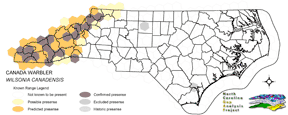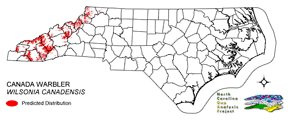
| Taxa: |
| Order: |
| Family: |
| Aves |
| Passeriformes |
| Parulidae |
| NatureServe Global Rank: |
| NatureServe State (NC) Rank: |
| G5 |
| S4B,SZN |
| Federal Status: |
| NC State Status: |
| --- |
| --- |


| Land Unit |
| US Fish & Wildlife Service |
| US Forest Service |
| US National Park Service |
| US Department of Defense |
| NC State Parks |
| NC University System |
| NC Wildlife Res. Com. |
| NC Forest Service |
| NC Div. of Coastal Mgmt. |
| Local Governments |
| Non-Governmental Org. |
| Other Public Lands |
| Private Lands |
| GAP Status 1-2 |
| All Protected Lands |
| Statewide |
| Hectares |
| 0.00 |
| 134,277.48 |
| 0.00 |
| 65,115.27 |
| 872.28 |
| 49.50 |
| 1,727.19 |
| 28.35 |
| 0.00 |
| 4,628.16 |
| 5,006.97 |
| 3.60 |
| 184,568.31 |
| 89,564.13 |
| 211,616.10 |
| 396,277.11 |
| Acres |
| 0.00 |
| 331,806.81 |
| 0.00 |
| 160,903.30 |
| 2,155.45 |
| 122.32 |
| 4,267.98 |
| 175.02 |
| 0.00 |
| 11,436.43 |
| 12,372.49 |
| 8.90 |
| 456,078.14 |
| 221,422.71 |
| 523,019.64 |
| 979,326.84 |
| % of Dist. on |
| Prot. Lands |
| 0.0 % |
| 63.5 % |
| 0.0 % |
| 30.8 % |
| 0.4 % |
| < 0.1 % |
| 0.8 % |
| < 0.1 % |
| 0.0 % |
| 2.3 % |
| 2.3 % |
| 0.0 % |
| 0.0 % |
| 42.3 % |
| ----- |
| ----- |
| % of Dist. on |
| All Lands |
| 0.0 % |
| 33.9 % |
| 0.0 % |
| 16.4 % |
| 0.2 % |
| < 0.1 % |
| 0.4 % |
| < 0.1 % |
| 0.0 % |
| 1.2 % |
| 1.3 % |
| < 0.1 % |
| 46.6 % |
| 22.6 % |
| ----- |
| ----- |
|
Potter et al (1980) records this species as a resident of the western North Carolina mountains. Breeds in cool deciduous, coniferous, or mixed woodlands with dense undergrowth or thickets. (Curson et al 1994, Dunn and Garrett 1997, Potter et al 1980) Simpson (1992) notes the use of heath balds also. Moist situations, i.e. near water or damp locations, are preferred (Alsop 1991,Curson et al 1994, Dunn and Garrett 1997). Dunn and Garrett (1997) state this species is likely to be found in 'rhododendron thickets within forests of hemlock, etc.' Alsop (1991) asserts in the higher elevations 'one to two breeding pairs' can be located in most clumps of rhododendron. In lower elevations Dunn and Garrett (1997) suggest Canada warblers prefer ravines with thickets of mountain laurel or rhododendron and in the highest portions of the range they will use 'tangles, stunted growth and wet mossy areas.' NATURE SERVE GLOBAL HABITAT COMMENTS: Woodland undergrowth (especially aspen-poplar), bogs, tall shrubbery along streams or near swamps, and deciduous second growth. In migration in various forest, woodland, scrub, and thicket habitats, mostly in humid areas. In winter in forested areas of foothills and mountains. BREEDING: Nests on or near ground, in roots of fallen tree, in cavity in bank, or on the side of rocks, on a ledge, on a hummock, stump, of fallen log, or on ground under a shrub (Harrison 1978). |
| Code | Name | Description | NC Natural Heritage Program Equivalent |
| 51 | Deciduous Cultivated Plantation | Planted deciduous trees. Includes sweetgum and sycamore plantations. | No equivalent |
| 517 | Hemlock Floodplain Forest | Alluvial forest with hemlock and/or white pine in mountains and western piedmont. Hydrology is generally temporarily to seasonally flooded. | Canada Hemlock Forest |
| 521 | Spruce/Fir Forest | High Elevation Frazer-Fir - Red Spruce, Red Spruce and Red-Spruce-Yellow Birch Forests. Tree densities included here include both woodland to forest density. Highly intermixed with Northern Hardwoods, Grassy Balds, and Shrub Balds. | Red Spruce--Fraser Fir Forest, Fraser Fir Forest |
| 522 | Northern Hardwoods | High Elevation forests including yellow birch, American beech, and yellow buckeye. Includes forests with Hemlock and Yellow Birch. | Northern Hardwoods Forest, Boulderfield Forest |
| 524 | Shrub Bald | Variable phenologies, predominantly evergreen balds with rhododendon and Mountain laurels. Deciduous shrubs including green alder and Alleghany and smooth blackberry are included as well. Red Oak - Chestnut Oak Woodlands may be included in cases where the density of the woodland species is low and the shrub component is dense. | Heath Bald |
| 525 | Appalachian Oak Forest | A variety of oak forest types including Black, White, Scarlet Oaks in dry to mesic situations. Includes forests historically co-dominated by American Chestnut. | High Elevation Red Oak Forest, Montane White Oak Forest |
| 526 | Appalachian Cove Forest | Mixed Mesophytic forests of the mountains. Includes tuliptree, basswood, yellow buckeye and surgar maple. This class is mapped to include cove forests dominated or co-dominated by hemlock. | Rich Cove Forest, Acidic Cove Forest |
| 527 | Appalachian Hemlock | Upland hemlock forests of the moutains region. Vary from side slopes to steep slope positions. | Canada Hemlock Forest |
| 533 | Appalachian Swamp Forest | Evergreen and deciduous forests with saturated hydrologies. This class may contain a variety of trees species, including hemlock - red maple, pitch pine, and white pine forests. | Swamp Forest-Bog Complex, Southern Appalachian Bog, Southern Appalachian Fen |
|
Carter, M., G. Fenwick, C. Hunter, D. Pashley, D. Petit, J. Price, and J. Trapp. 1996. Watchlist 1996:For the future. Field Notes 50(3):238-240.
Simpson MB Jr. 1992. Birds of the Blue Ridge Mountains. Chapel Hill and London: University of North Carolina Press. Dunn, J.L., and K.L. Garrett. 1997. A field guide to warblers of North America. Houghton Mifflin Company, Boston. Harrison, C. 1978. A field guide to the nests, eggs and nestlings of North American birds. Collins, Cleveland, Ohio. Griscom, L., and A. Sprunt, Jr. 1979. The warblers of America. Doubleday and Co., Garden City, New York. 302 pp. Potter, E. F., J. F. Parnell, and R. P. Teulings. 1980. Birds of the Carolinas. Univ. North Carolina Press, Chapel Hill. 408 pp. Terres, J.K. 1980. The Audubon Society encyclopedia of North American birds. Alfred A. Knopf, New York. American Ornithologists' Union (AOU), Committee on Classification and Nomenclature. 1983. Check-list of North American Birds. Sixth Edition. American Ornithologists' Union, Allen Press, Inc., Lawrence, Kansas. Harrison, H.H. 1984. Wood warblers' world. Simon and Schuster, New York. 335 pp. Ridgely, R.S., and G. Tudor. 1989. The birds of South America. Vol. 1. The Oscine passerines. Univ. Texas Press, Austin. 516 pp. Stiles, F.G., and A.F. Skutch. 1989. A guide to the birds of Costa Rica. Comstock Publ. Associates, Cornell University Press, Ithaca, New York. 511 pp. Alsop FJ III. 1991. Birds of the Smokies. Gatlinburg: Great Smoky Mountains Natural History Association. |
For more information please contact them at:
NC-GAP Analysis Project
Dept. of Zoology, NCSU
Campus Box 7617
Raleigh, NC 27695-7617
(919) 513-2853
www.basic.ncsu.edu/ncgap